The Northern Crusades or Baltic Crusades were Christian colonization and Christianization campaigns undertaken by Catholic Christian military orders and kingdoms, primarily against the pagan Baltic, Finnic and West Slavic peoples around the southern and eastern shores of the Baltic Sea, and also against Orthodox Christian Slavs.

A hillfort is a type of earthwork used as a fortified refuge or defended settlement, located to exploit a rise in elevation for defensive advantage. They are typically European and of the Bronze Age or Iron Age. Some were used in the post-Roman period. The fortification usually follows the contours of a hill and consists of one or more lines of earthworks, with stockades or defensive walls, and external ditches.
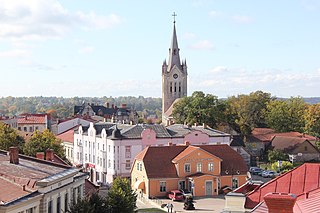
Cēsis, is a town in Latvia located in the northern part of the Central Vidzeme Upland. Cēsis is on the Gauja River valley, and is built on a series of ridges above the river overlooking the woods below. Cēsis was one of the candidate cities for the title of European Capital of Culture 2014.
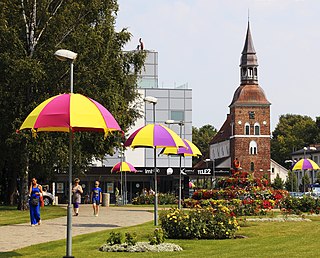
Valmiera is the largest city of the historical Vidzeme region, Latvia, with a total area of 19.35 square kilometres. As of 2002, Valmiera had a population of 27,323, and in 2020 – 24 879. It is a state city the seat of Valmiera Municipality.

Viljandi is a town and municipality in southern Estonia with a population of 17,407 in 2019. It is the capital of Viljandi County and is geographically located between two major Estonian cities, Pärnu and Tartu. The town was first mentioned in 1283, upon being granted its town charter by Wilhelm von Endorpe. The town became a member of the Hanseatic League at the beginning of the 14th century, and is one of five Estonian towns and cities in the league. The once influential Estonian newspaper Sakala was founded in Viljandi in 1878.
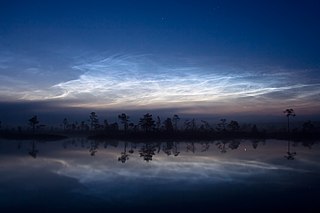
Viljandi County is one of 15 counties of Estonia. It is located in southern Estonia bordering Pärnu, Järva, Jõgeva, Tartu and Valga counties.
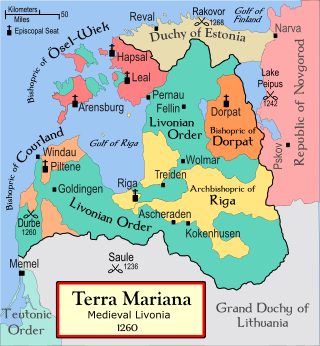
The Bishopric of Dorpat was a medieval prince-bishopric, i.e. both a diocese of the Roman Catholic Church and a temporal principality ruled by the bishop of the diocese. It existed from 1224 to 1558, generally encompassing the area that now comprises Tartu County, Põlva County, Võru County, and Jõgeva County in Estonia. The prince-bishopric was a sovereign member of the Holy Roman Empire and part of the Livonian Confederation until its dissolution in 1561.

Rakvere is a town in northern Estonia and the administrative centre of the Lääne-Viru maakond (county), 20 km south of the Gulf of Finland of the Baltic Sea. Rakvere is the 8th most populous urban area in Estonia. Rakvere has a total area of 10.75 square kilometres, and although about 15% of Rakvere is covered by forest, it is still the country's third most densely populated urban area. From the 13th century until the early 20th century, Rakvere was more widely known by its historical German name, Wesenberg(h).
Koknese is a town in Aizkraukle Municipality in the Vidzeme region of Latvia, on the right bank of the Daugava River. It has a population of nearly 3,000.
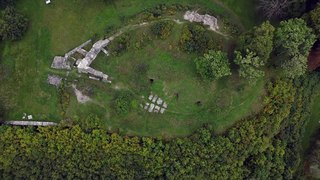
Lihula is a town in Lääneranna Parish, Pärnu County, Estonia.
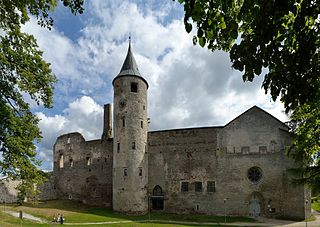
Haapsalu Castle is a castle with cathedral in Haapsalu, Estonia, founded in the thirteenth century as the seat of the Bishopric of Ösel-Wiek. According to legend, during full moons in August, an image of a maiden, The White Lady, appears on the inner wall of the chapel.

Karksi-Nuia is a town in Mulgi Parish, Viljandi County, southern Estonia close to the Latvian border. The nearest villages are Univere to the west, Polli and Karksi to the north, and Kõvaküla to the south.

The Livonian crusade consists of the various military Christianisation campaigns in medieval Livonia – modern Latvia and Estonia – during the Papal-sanctioned Northern Crusades in the 12–13th century. The Livonian crusade was conducted mostly by the Holy Roman Empire and the Kingdom of Denmark. It ended with the creation of Terra Mariana and the Danish duchy of Estonia. The lands on the eastern shores of the Baltic Sea were one of the last parts of Europe to be Christianised.

Gaujiena Castle is a castle in the historical region of Vidzeme, in northern Latvia. It was built between 1236 and 1238. Severely damaged in 1702 during the Great Northern War, the structure was abandoned.

Dobele Castle is a castle in the town of Dobele in the historical region of Zemgale, Latvia. The Livonian order built the castle on the west bank of the Berze river in 1335, on the site of an old hillfort.

Tartu Cathedral, earlier also known as Dorpat Cathedral, is a former Catholic church in Tartu (Dorpat), Estonia. The building is now an imposing ruin overlooking the lower town. In the small part of it that has been renovated is now located the museum of the University of Tartu, which the university also uses for major receptions.

Karksi Parish was a rural municipality of Estonia, in Viljandi County. In 2009, it has a population of 4,041 and an area of 321.45 km2.
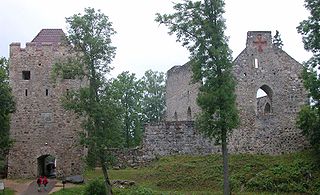
Sigulda Medieval Castle ruins are located on the edge of the Gauja valley in Latvia. The original castle was built in 1207 as a castellum type fortress, later rebuilt into a convent type building. The residence of the Land Marshal of the Livonian Order since 1432.

Laiuse Castle was a Livonian Order castle in Laiusevälja, Jõgeva Parish, Estonia. The castle is now in ruins.

Sēlpils Castle is an ancient castle in Sēlpils Parish, Jēkabpils Municipality in the Selonia region of Latvia.




















